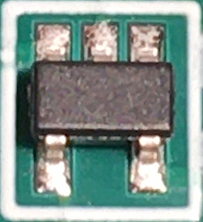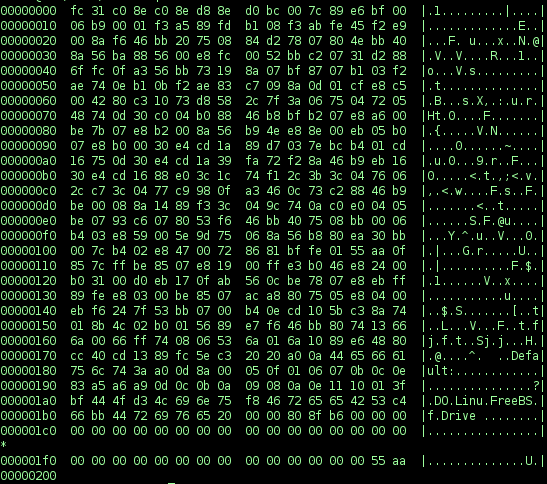|
Runit
runit is an init and service management scheme for Unix-like Operating systems that initializes, supervises, and ends processes throughout the operating system. Runit is a reimplementation of the daemontools process supervision toolkit that runs on many Linux-based operating systems, as well as BSD, and Solaris operating systems. Runit features parallelization of the start up of system services, which can speed up the boot time of the operating system. When running as an init daemon, Runit is the direct or indirect ancestor of all other processes. It is the first process started during booting, and continues running until the system is shut down. It is often used with other init systems as a separate service manager. In the service manager role, it can be used by unprivileged users to orchestrate personal services, as well as by root to manage services not otherwise managed by the init system currently in use. Design Runit focuses on being a small, modular, and portable c ... [...More Info...] [...Related Items...] OR: [Wikipedia] [Google] [Baidu] |
Process Supervision
Process supervision is a form of operating system service management in which some master process remains the parent of the service processes. Benefits Benefits compared to traditional process launchers and system boot mechanisms, like System V init, include: * Ability to restart services which have failed * The fact that it does not require the use of "pidfiles" * Clean process state * Reliable logging, because the master process can capture the stdout/stderr of the service process and route it to a log * Faster (concurrent) and ability to start up and stop Implementations * daemontools daemontools-encore Derived from the public-domain release of daemontools Eye A Ruby implementation Finit Fast, Extensible Init for Linux Systems God A Ruby implementation immortal A Go implementation * PM2: A Process Manager for Node.js * Initng * launchd minit A small, yet feature-complete Linux init * Monit * runit Supervisor A Python implementation s6 Low-level process and service sup ... [...More Info...] [...Related Items...] OR: [Wikipedia] [Google] [Baidu] |
Sysvinit
In Unix-based computer operating systems, init (short for ''initialization'') is the first process started during booting of the operating system. Init is a daemon process that continues running until the system is shut down. It is the direct or indirect ancestor of all other processes and automatically adopts all orphaned processes. Init is started by the kernel during the booting process; a kernel panic will occur if the kernel is unable to start it, or it should die for any reason. Init is typically assigned process identifier 1. In Unix systems such as System III and System V, the design of init has diverged from the functionality provided by the init in Research Unix and its Berkeley Software Distribution, BSD derivatives. Up until the early 2010s, most Linux distributions employed a traditional init that was somewhat compatible with System V, while some distributions such as Slackware Linux, Slackware use BSD-style startup scripts, and other distributions such a ... [...More Info...] [...Related Items...] OR: [Wikipedia] [Google] [Baidu] |
Init
In Unix-based computer operating systems, init (short for ''initialization'') is the first process started during booting of the operating system. Init is a daemon process that continues running until the system is shut down. It is the direct or indirect ancestor of all other processes and automatically adopts all orphaned processes. Init is started by the kernel during the booting process; a kernel panic will occur if the kernel is unable to start it, or it should die for any reason. Init is typically assigned process identifier 1. In Unix systems such as System III and System V, the design of init has diverged from the functionality provided by the init in Research Unix and its BSD derivatives. Up until the early 2010s, most Linux distributions employed a traditional init that was somewhat compatible with System V, while some distributions such as Slackware use BSD-style startup scripts, and other distributions such as Gentoo have their own customized versions ... [...More Info...] [...Related Items...] OR: [Wikipedia] [Google] [Baidu] |
Daemontools
daemontools is a process supervision toolkit written by Daniel J. Bernstein as an alternative to other system initialization and process supervision tools, such as Init. Some of the features of daemontools are: * Easy service installation and removal * Easy first-time service startup * Reliable restarts * Easy, reliable signalling * Clean process state * Portability Similar applications are runit runit is an init and service management scheme for Unix-like Operating systems that initializes, supervises, and ends processes throughout the operating system. Runit is a reimplementation of the daemontools process supervision toolkit that ..., s6, and daemontools-encore. References External links maintained by the author Public-domain software with source code Unix process- and task-management-related software {{Unix-stub ... [...More Info...] [...Related Items...] OR: [Wikipedia] [Google] [Baidu] |
Init
In Unix-based computer operating systems, init (short for ''initialization'') is the first process started during booting of the operating system. Init is a daemon process that continues running until the system is shut down. It is the direct or indirect ancestor of all other processes and automatically adopts all orphaned processes. Init is started by the kernel during the booting process; a kernel panic will occur if the kernel is unable to start it, or it should die for any reason. Init is typically assigned process identifier 1. In Unix systems such as System III and System V, the design of init has diverged from the functionality provided by the init in Research Unix and its BSD derivatives. Up until the early 2010s, most Linux distributions employed a traditional init that was somewhat compatible with System V, while some distributions such as Slackware use BSD-style startup scripts, and other distributions such as Gentoo have their own customized versions ... [...More Info...] [...Related Items...] OR: [Wikipedia] [Google] [Baidu] |
Watchdog Timer
A watchdog timer (WDT, or simply a ''watchdog''), sometimes called a ''computer operating properly timer'' (''COP timer''), is an electronic or software timer that is used to detect and recover from computer malfunctions. Watchdog timers are widely used in computers to facilitate automatic correction of temporary hardware faults, and to prevent errant or malevolent software from disrupting system operation. During normal operation, the computer regularly restarts the watchdog timer to prevent it from elapsing, or ''timeout (computing), timing out''. If, due to a hardware fault or program error, the computer fails to restart the watchdog, the timer will elapse and generate a timeout signal. The timeout signal is used to initiate corrective actions. The corrective actions typically include placing the computer and associated hardware in a safe state and invoking a computer reboot. Microcontrollers often include an integrated, on-chip watchdog. In other computers the watchdog may re ... [...More Info...] [...Related Items...] OR: [Wikipedia] [Google] [Baidu] |
POSIX
The Portable Operating System Interface (POSIX; ) is a family of standards specified by the IEEE Computer Society for maintaining compatibility between operating systems. POSIX defines application programming interfaces (APIs), along with command line shells and utility interfaces, for software compatibility (portability) with variants of Unix and other operating systems. POSIX is also a trademark of the IEEE. POSIX is intended to be used by both application and system developers. As of POSIX 2024, the standard is aligned with the C17 language standard. Name Originally, the name "POSIX" referred to IEEE Std 1003.1-1988, released in 1988. The family of POSIX standards is formally designated as IEEE 1003 and the ISO/IEC standard number is ISO/ IEC 9945. The standards emerged from a project that began in 1984 building on work from related activity in the ''/usr/group'' association. Richard Stallman suggested the name ''POSIX'' to the IEEE instead of the former ''IEEE-IX''. Th ... [...More Info...] [...Related Items...] OR: [Wikipedia] [Google] [Baidu] |
Codebase
In software development, a codebase (or code base) is a collection of source code used to build a particular software system, application, or software component. Typically, a codebase includes only human-written source code system files; thus, a codebase usually does not include source code files generated by tools (generated files) or binary library files (object files), as they can be built from the human-written source code. However, it generally does include configuration and property files, as they are the data necessary for the build. A codebase is typically stored in a source control repository in a version control system. A source code repository is a place where large amounts of source code are kept, either publicly or privately. Source code repositories are used most basically for backups and versioning, and on multi-developer projects to handle various source code versions and to provide aid in resolving conflicts that arise from developers submitting overlapping ... [...More Info...] [...Related Items...] OR: [Wikipedia] [Google] [Baidu] |
Executable
In computer science, executable code, an executable file, or an executable program, sometimes simply referred to as an executable or binary, causes a computer "to perform indicated tasks according to encoded instruction (computer science), instructions", as opposed to a data (computing), data file that must be interpreted (parser, parsed) by an interpreter (computing), interpreter to be functional. The exact interpretation depends upon the use. "Instructions" is traditionally taken to mean machine code instructions for a physical central processing unit, CPU. In some contexts, a file containing scripting instructions (such as bytecode) may also be considered executable. Generation of executable files Executable files can be hand-coded in machine language, although it is far more convenient to develop software as source code in a high-level language that can be easily understood by humans. In some cases, source code might be specified in assembly language instead, which rema ... [...More Info...] [...Related Items...] OR: [Wikipedia] [Google] [Baidu] |
Portable Software
A portable application (portable app), sometimes also called Standalone program, standalone software, is a computer program designed to operate without changing other files or requiring other software to be installed. In this way, it can be easily added to, run, and removed from any compatible computer without setup or side-effects. In practical terms, a portable application often stores user-created data and configuration settings in the same directory it resides in. This makes it easier to transfer the program with the user's preferences and data between different computers. A program that doesn't have any configuration options can also be a portable application. Portable applications can be stored on any data storage device, including internal mass storage, a Shared resource, file share, File hosting service, cloud storage or external storage such as USB flash drive, USB drives, pen drives and floppy disks—storing its program files and any configuration information and dat ... [...More Info...] [...Related Items...] OR: [Wikipedia] [Google] [Baidu] |
Superuser
In computing, the superuser is a special user account used for system administration. Depending on the operating system (OS), the actual name of this account might be root, administrator, admin or supervisor. In some cases, the actual name of the account is not the determining factor; on Unix-like systems, for example, the user with a user identifier (UID) of zero is the superuser .e., uid=0 regardless of the name of that account; and in systems which implement a r model, any user with the role of superuser (or its synonyms) can carry out all actions of the superuser account. The principle of least privilege recommends that most users and applications run under an ordinary account to perform their work, as a superuser account is capable of making unrestricted, potentially adverse, system-wide changes. Unix and Unix-like In Unix-like computer OSes (such as Linux), ''root'' is the conventional name of the user who has all rights or permissions (to all files and programs) in all mod ... [...More Info...] [...Related Items...] OR: [Wikipedia] [Google] [Baidu] |





